APC308 Financial Management: Valuation and Investment Analysis
VerifiedAdded on 2023/01/12
|16
|3075
|61
Report
AI Summary
This report provides a comprehensive analysis of financial management principles, focusing on valuation techniques and investment appraisal methods. It begins with an introduction to financial management, emphasizing its role in achieving business goals. The report then delves into the intricacies of mergers and takeovers, exploring valuation techniques such as the Price Earnings Ratio, Dividend Valuation Method, and Discounted Cash Flow, critically discussing their benefits and limitations. The analysis extends to investment appraisal techniques, including Payback Period, Accounting Rate of Return (ARR), Net Present Value (NPV), and Internal Rate of Return (IRR), providing detailed calculations and interpretations for a case study involving Lovewell Limited. The report concludes by summarizing the findings and emphasizing the importance of considering various factors when making financial decisions, offering valuable insights for financial management students and professionals.

Financial Management
Paraphrase This Document
Need a fresh take? Get an instant paraphrase of this document with our AI Paraphraser

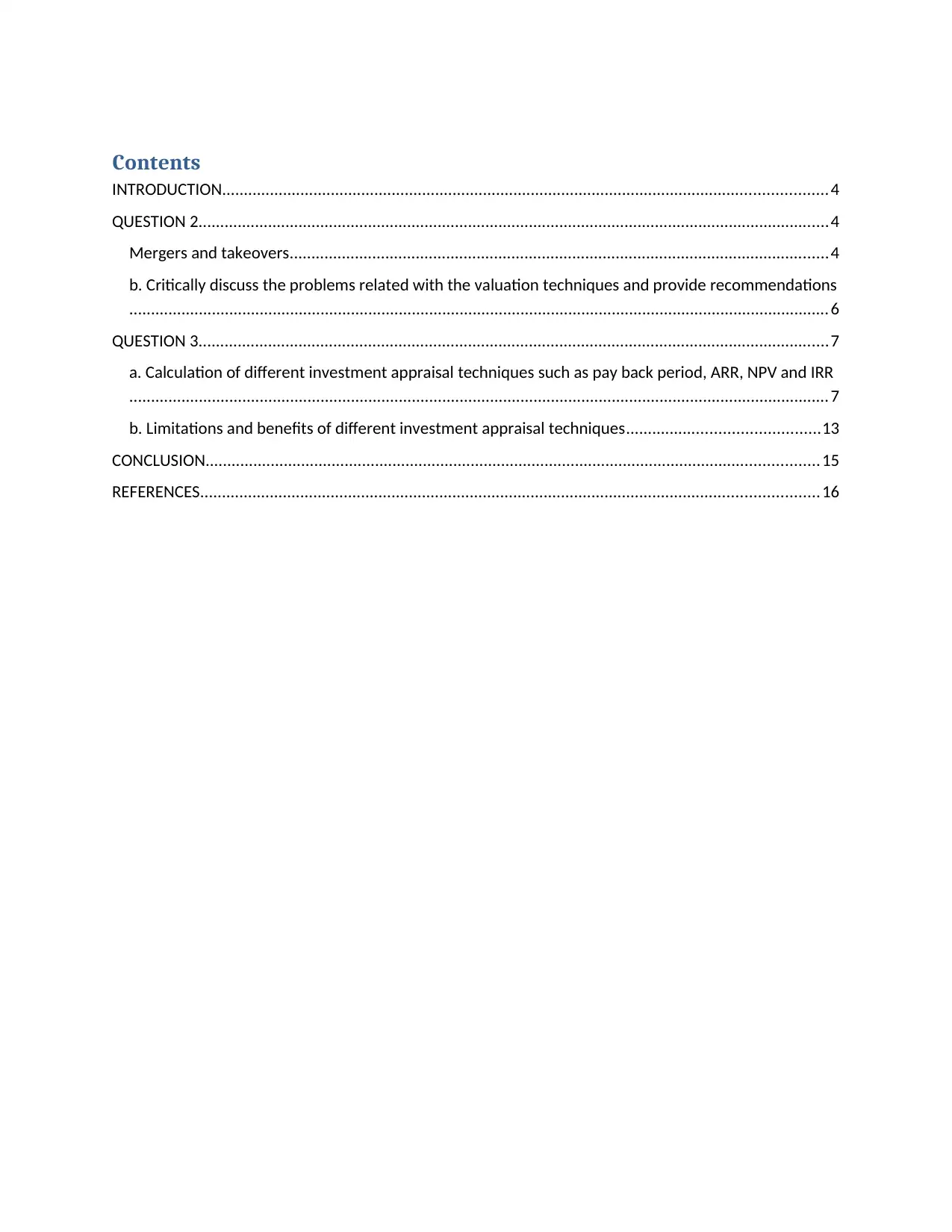
Contents
INTRODUCTION...........................................................................................................................................4
QUESTION 2.................................................................................................................................................4
Mergers and takeovers............................................................................................................................4
b. Critically discuss the problems related with the valuation techniques and provide recommendations
.................................................................................................................................................................6
QUESTION 3.................................................................................................................................................7
a. Calculation of different investment appraisal techniques such as pay back period, ARR, NPV and IRR
.................................................................................................................................................................7
b. Limitations and benefits of different investment appraisal techniques............................................13
CONCLUSION.............................................................................................................................................15
REFERENCES..............................................................................................................................................16
INTRODUCTION...........................................................................................................................................4
QUESTION 2.................................................................................................................................................4
Mergers and takeovers............................................................................................................................4
b. Critically discuss the problems related with the valuation techniques and provide recommendations
.................................................................................................................................................................6
QUESTION 3.................................................................................................................................................7
a. Calculation of different investment appraisal techniques such as pay back period, ARR, NPV and IRR
.................................................................................................................................................................7
b. Limitations and benefits of different investment appraisal techniques............................................13
CONCLUSION.............................................................................................................................................15
REFERENCES..............................................................................................................................................16
⊘ This is a preview!⊘
Do you want full access?
Subscribe today to unlock all pages.

Trusted by 1+ million students worldwide
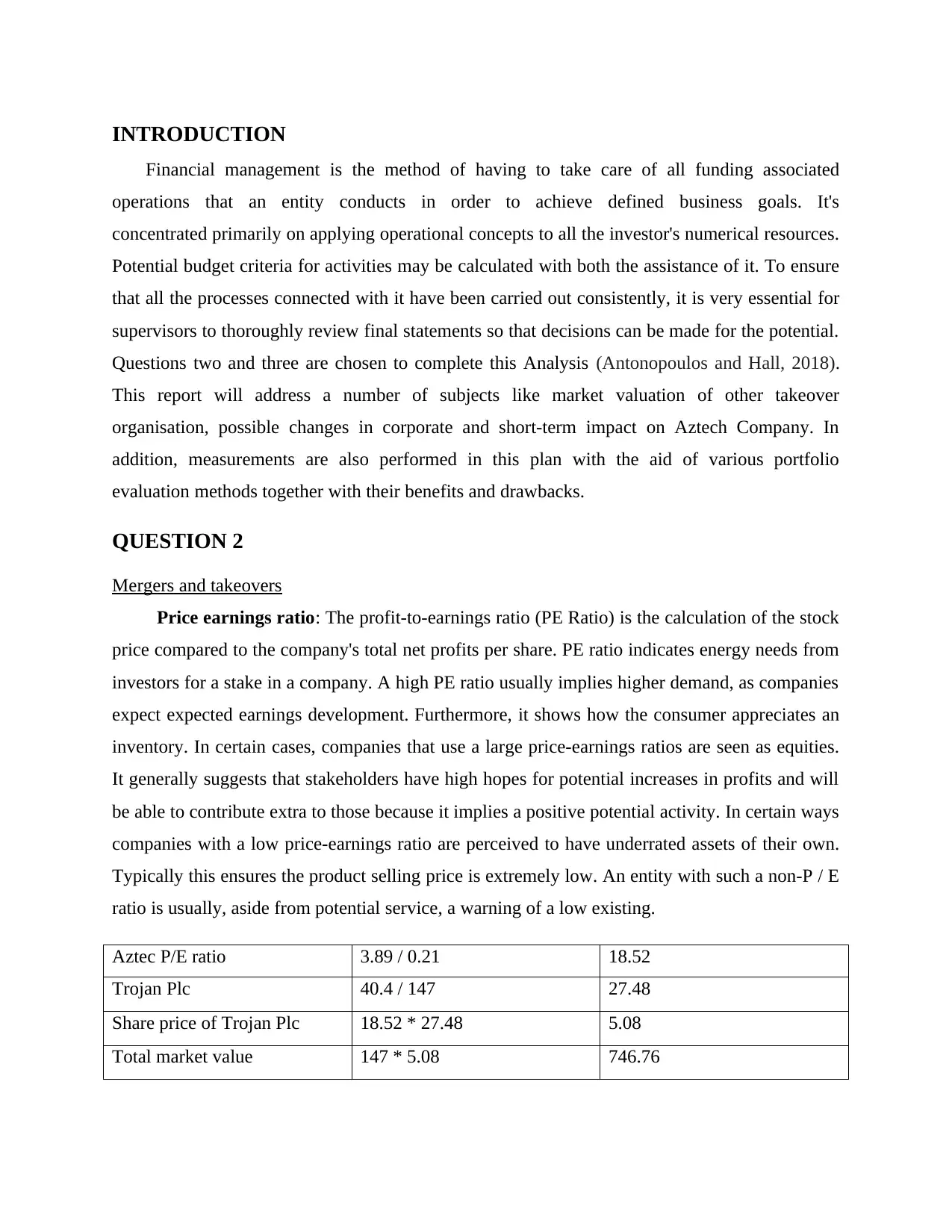
INTRODUCTION
Financial management is the method of having to take care of all funding associated
operations that an entity conducts in order to achieve defined business goals. It's
concentrated primarily on applying operational concepts to all the investor's numerical resources.
Potential budget criteria for activities may be calculated with both the assistance of it. To ensure
that all the processes connected with it have been carried out consistently, it is very essential for
supervisors to thoroughly review final statements so that decisions can be made for the potential.
Questions two and three are chosen to complete this Analysis (Antonopoulos and Hall, 2018).
This report will address a number of subjects like market valuation of other takeover
organisation, possible changes in corporate and short-term impact on Aztech Company. In
addition, measurements are also performed in this plan with the aid of various portfolio
evaluation methods together with their benefits and drawbacks.
QUESTION 2
Mergers and takeovers
Price earnings ratio: The profit-to-earnings ratio (PE Ratio) is the calculation of the stock
price compared to the company's total net profits per share. PE ratio indicates energy needs from
investors for a stake in a company. A high PE ratio usually implies higher demand, as companies
expect expected earnings development. Furthermore, it shows how the consumer appreciates an
inventory. In certain cases, companies that use a large price-earnings ratios are seen as equities.
It generally suggests that stakeholders have high hopes for potential increases in profits and will
be able to contribute extra to those because it implies a positive potential activity. In certain ways
companies with a low price-earnings ratio are perceived to have underrated assets of their own.
Typically this ensures the product selling price is extremely low. An entity with such a non-P / E
ratio is usually, aside from potential service, a warning of a low existing.
Aztec P/E ratio 3.89 / 0.21 18.52
Trojan Plc 40.4 / 147 27.48
Share price of Trojan Plc 18.52 * 27.48 5.08
Total market value 147 * 5.08 746.76
Financial management is the method of having to take care of all funding associated
operations that an entity conducts in order to achieve defined business goals. It's
concentrated primarily on applying operational concepts to all the investor's numerical resources.
Potential budget criteria for activities may be calculated with both the assistance of it. To ensure
that all the processes connected with it have been carried out consistently, it is very essential for
supervisors to thoroughly review final statements so that decisions can be made for the potential.
Questions two and three are chosen to complete this Analysis (Antonopoulos and Hall, 2018).
This report will address a number of subjects like market valuation of other takeover
organisation, possible changes in corporate and short-term impact on Aztech Company. In
addition, measurements are also performed in this plan with the aid of various portfolio
evaluation methods together with their benefits and drawbacks.
QUESTION 2
Mergers and takeovers
Price earnings ratio: The profit-to-earnings ratio (PE Ratio) is the calculation of the stock
price compared to the company's total net profits per share. PE ratio indicates energy needs from
investors for a stake in a company. A high PE ratio usually implies higher demand, as companies
expect expected earnings development. Furthermore, it shows how the consumer appreciates an
inventory. In certain cases, companies that use a large price-earnings ratios are seen as equities.
It generally suggests that stakeholders have high hopes for potential increases in profits and will
be able to contribute extra to those because it implies a positive potential activity. In certain ways
companies with a low price-earnings ratio are perceived to have underrated assets of their own.
Typically this ensures the product selling price is extremely low. An entity with such a non-P / E
ratio is usually, aside from potential service, a warning of a low existing.
Aztec P/E ratio 3.89 / 0.21 18.52
Trojan Plc 40.4 / 147 27.48
Share price of Trojan Plc 18.52 * 27.48 5.08
Total market value 147 * 5.08 746.76
Paraphrase This Document
Need a fresh take? Get an instant paraphrase of this document with our AI Paraphraser
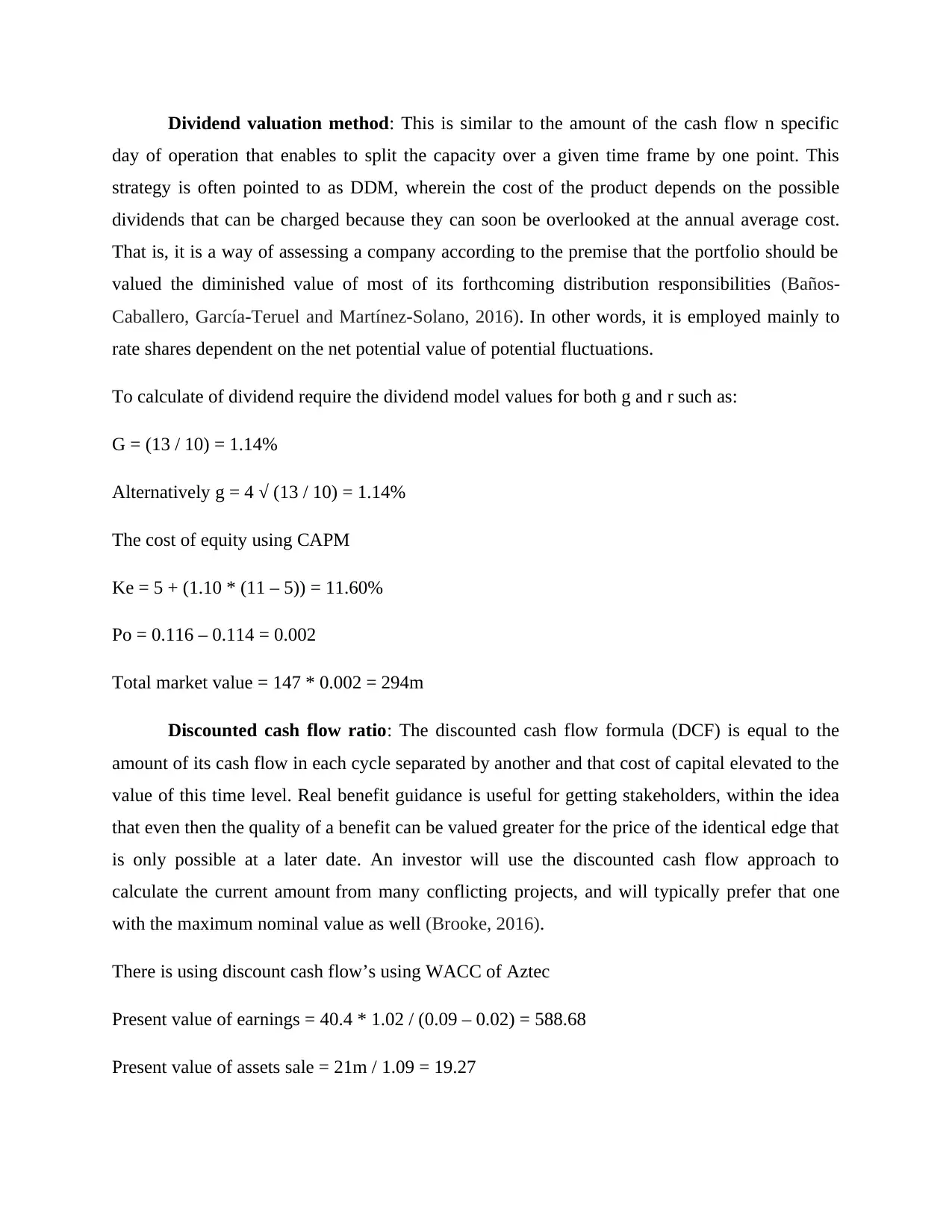
Dividend valuation method: This is similar to the amount of the cash flow n specific
day of operation that enables to split the capacity over a given time frame by one point. This
strategy is often pointed to as DDM, wherein the cost of the product depends on the possible
dividends that can be charged because they can soon be overlooked at the annual average cost.
That is, it is a way of assessing a company according to the premise that the portfolio should be
valued the diminished value of most of its forthcoming distribution responsibilities (Baños-
Caballero, García-Teruel and Martínez-Solano, 2016). In other words, it is employed mainly to
rate shares dependent on the net potential value of potential fluctuations.
To calculate of dividend require the dividend model values for both g and r such as:
G = (13 / 10) = 1.14%
Alternatively g = 4 √ (13 / 10) = 1.14%
The cost of equity using CAPM
Ke = 5 + (1.10 * (11 – 5)) = 11.60%
Po = 0.116 – 0.114 = 0.002
Total market value = 147 * 0.002 = 294m
Discounted cash flow ratio: The discounted cash flow formula (DCF) is equal to the
amount of its cash flow in each cycle separated by another and that cost of capital elevated to the
value of this time level. Real benefit guidance is useful for getting stakeholders, within the idea
that even then the quality of a benefit can be valued greater for the price of the identical edge that
is only possible at a later date. An investor will use the discounted cash flow approach to
calculate the current amount from many conflicting projects, and will typically prefer that one
with the maximum nominal value as well (Brooke, 2016).
There is using discount cash flow’s using WACC of Aztec
Present value of earnings = 40.4 * 1.02 / (0.09 – 0.02) = 588.68
Present value of assets sale = 21m / 1.09 = 19.27
day of operation that enables to split the capacity over a given time frame by one point. This
strategy is often pointed to as DDM, wherein the cost of the product depends on the possible
dividends that can be charged because they can soon be overlooked at the annual average cost.
That is, it is a way of assessing a company according to the premise that the portfolio should be
valued the diminished value of most of its forthcoming distribution responsibilities (Baños-
Caballero, García-Teruel and Martínez-Solano, 2016). In other words, it is employed mainly to
rate shares dependent on the net potential value of potential fluctuations.
To calculate of dividend require the dividend model values for both g and r such as:
G = (13 / 10) = 1.14%
Alternatively g = 4 √ (13 / 10) = 1.14%
The cost of equity using CAPM
Ke = 5 + (1.10 * (11 – 5)) = 11.60%
Po = 0.116 – 0.114 = 0.002
Total market value = 147 * 0.002 = 294m
Discounted cash flow ratio: The discounted cash flow formula (DCF) is equal to the
amount of its cash flow in each cycle separated by another and that cost of capital elevated to the
value of this time level. Real benefit guidance is useful for getting stakeholders, within the idea
that even then the quality of a benefit can be valued greater for the price of the identical edge that
is only possible at a later date. An investor will use the discounted cash flow approach to
calculate the current amount from many conflicting projects, and will typically prefer that one
with the maximum nominal value as well (Brooke, 2016).
There is using discount cash flow’s using WACC of Aztec
Present value of earnings = 40.4 * 1.02 / (0.09 – 0.02) = 588.68
Present value of assets sale = 21m / 1.09 = 19.27
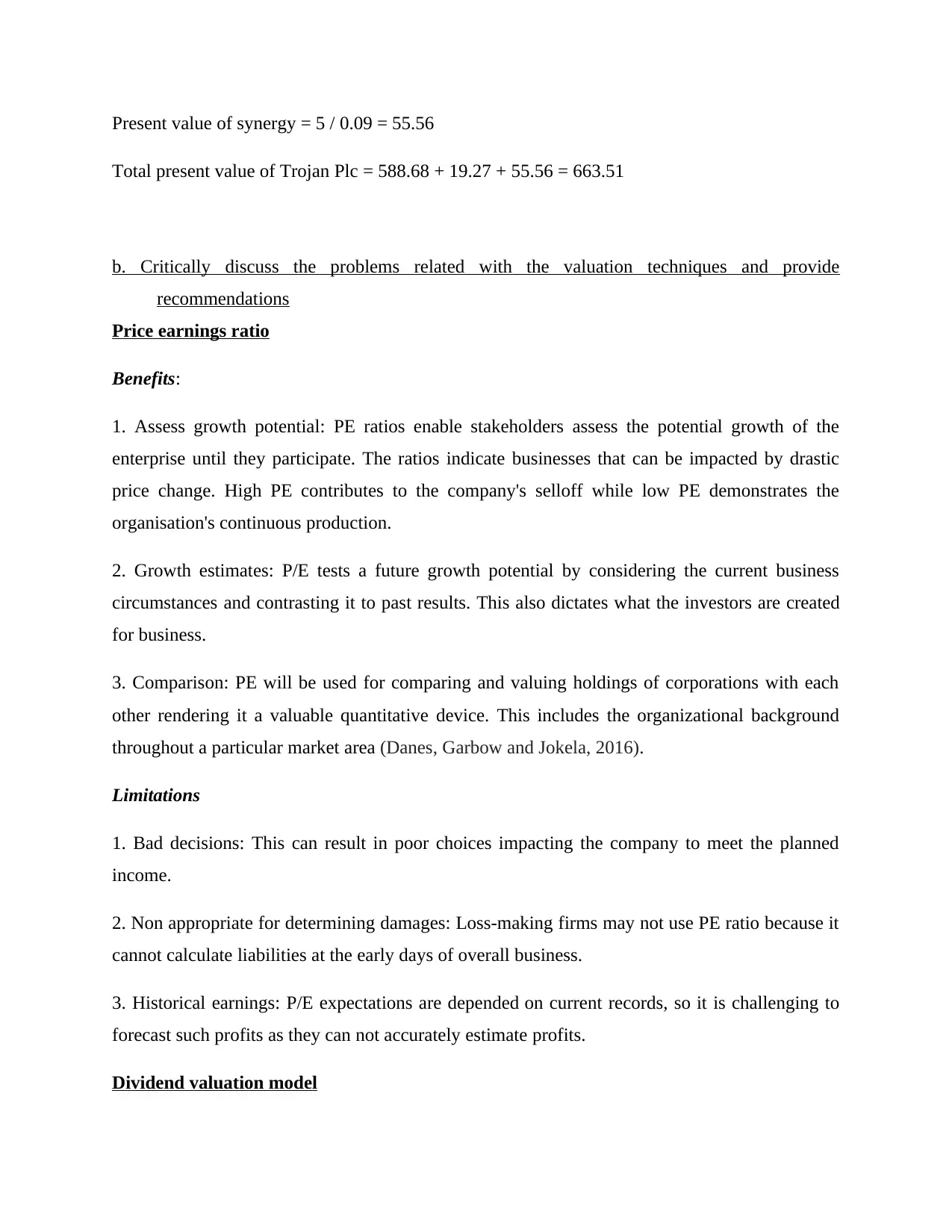
Present value of synergy = 5 / 0.09 = 55.56
Total present value of Trojan Plc = 588.68 + 19.27 + 55.56 = 663.51
b. Critically discuss the problems related with the valuation techniques and provide
recommendations
Price earnings ratio
Benefits:
1. Assess growth potential: PE ratios enable stakeholders assess the potential growth of the
enterprise until they participate. The ratios indicate businesses that can be impacted by drastic
price change. High PE contributes to the company's selloff while low PE demonstrates the
organisation's continuous production.
2. Growth estimates: P/E tests a future growth potential by considering the current business
circumstances and contrasting it to past results. This also dictates what the investors are created
for business.
3. Comparison: PE will be used for comparing and valuing holdings of corporations with each
other rendering it a valuable quantitative device. This includes the organizational background
throughout a particular market area (Danes, Garbow and Jokela, 2016).
Limitations
1. Bad decisions: This can result in poor choices impacting the company to meet the planned
income.
2. Non appropriate for determining damages: Loss-making firms may not use PE ratio because it
cannot calculate liabilities at the early days of overall business.
3. Historical earnings: P/E expectations are depended on current records, so it is challenging to
forecast such profits as they can not accurately estimate profits.
Dividend valuation model
Total present value of Trojan Plc = 588.68 + 19.27 + 55.56 = 663.51
b. Critically discuss the problems related with the valuation techniques and provide
recommendations
Price earnings ratio
Benefits:
1. Assess growth potential: PE ratios enable stakeholders assess the potential growth of the
enterprise until they participate. The ratios indicate businesses that can be impacted by drastic
price change. High PE contributes to the company's selloff while low PE demonstrates the
organisation's continuous production.
2. Growth estimates: P/E tests a future growth potential by considering the current business
circumstances and contrasting it to past results. This also dictates what the investors are created
for business.
3. Comparison: PE will be used for comparing and valuing holdings of corporations with each
other rendering it a valuable quantitative device. This includes the organizational background
throughout a particular market area (Danes, Garbow and Jokela, 2016).
Limitations
1. Bad decisions: This can result in poor choices impacting the company to meet the planned
income.
2. Non appropriate for determining damages: Loss-making firms may not use PE ratio because it
cannot calculate liabilities at the early days of overall business.
3. Historical earnings: P/E expectations are depended on current records, so it is challenging to
forecast such profits as they can not accurately estimate profits.
Dividend valuation model
⊘ This is a preview!⊘
Do you want full access?
Subscribe today to unlock all pages.

Trusted by 1+ million students worldwide
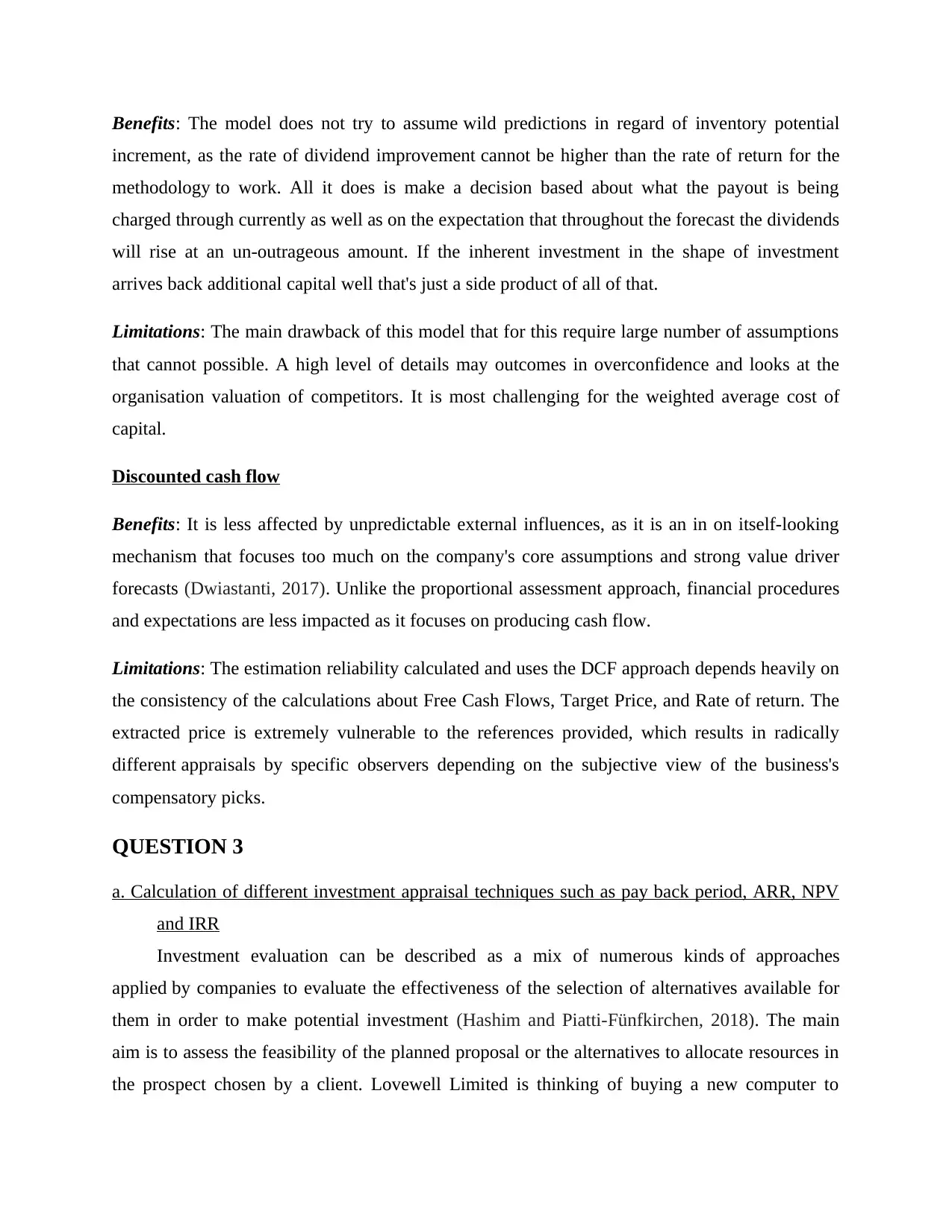
Benefits: The model does not try to assume wild predictions in regard of inventory potential
increment, as the rate of dividend improvement cannot be higher than the rate of return for the
methodology to work. All it does is make a decision based about what the payout is being
charged through currently as well as on the expectation that throughout the forecast the dividends
will rise at an un-outrageous amount. If the inherent investment in the shape of investment
arrives back additional capital well that's just a side product of all of that.
Limitations: The main drawback of this model that for this require large number of assumptions
that cannot possible. A high level of details may outcomes in overconfidence and looks at the
organisation valuation of competitors. It is most challenging for the weighted average cost of
capital.
Discounted cash flow
Benefits: It is less affected by unpredictable external influences, as it is an in on itself-looking
mechanism that focuses too much on the company's core assumptions and strong value driver
forecasts (Dwiastanti, 2017). Unlike the proportional assessment approach, financial procedures
and expectations are less impacted as it focuses on producing cash flow.
Limitations: The estimation reliability calculated and uses the DCF approach depends heavily on
the consistency of the calculations about Free Cash Flows, Target Price, and Rate of return. The
extracted price is extremely vulnerable to the references provided, which results in radically
different appraisals by specific observers depending on the subjective view of the business's
compensatory picks.
QUESTION 3
a. Calculation of different investment appraisal techniques such as pay back period, ARR, NPV
and IRR
Investment evaluation can be described as a mix of numerous kinds of approaches
applied by companies to evaluate the effectiveness of the selection of alternatives available for
them in order to make potential investment (Hashim and Piatti-Fünfkirchen, 2018). The main
aim is to assess the feasibility of the planned proposal or the alternatives to allocate resources in
the prospect chosen by a client. Lovewell Limited is thinking of buying a new computer to
increment, as the rate of dividend improvement cannot be higher than the rate of return for the
methodology to work. All it does is make a decision based about what the payout is being
charged through currently as well as on the expectation that throughout the forecast the dividends
will rise at an un-outrageous amount. If the inherent investment in the shape of investment
arrives back additional capital well that's just a side product of all of that.
Limitations: The main drawback of this model that for this require large number of assumptions
that cannot possible. A high level of details may outcomes in overconfidence and looks at the
organisation valuation of competitors. It is most challenging for the weighted average cost of
capital.
Discounted cash flow
Benefits: It is less affected by unpredictable external influences, as it is an in on itself-looking
mechanism that focuses too much on the company's core assumptions and strong value driver
forecasts (Dwiastanti, 2017). Unlike the proportional assessment approach, financial procedures
and expectations are less impacted as it focuses on producing cash flow.
Limitations: The estimation reliability calculated and uses the DCF approach depends heavily on
the consistency of the calculations about Free Cash Flows, Target Price, and Rate of return. The
extracted price is extremely vulnerable to the references provided, which results in radically
different appraisals by specific observers depending on the subjective view of the business's
compensatory picks.
QUESTION 3
a. Calculation of different investment appraisal techniques such as pay back period, ARR, NPV
and IRR
Investment evaluation can be described as a mix of numerous kinds of approaches
applied by companies to evaluate the effectiveness of the selection of alternatives available for
them in order to make potential investment (Hashim and Piatti-Fünfkirchen, 2018). The main
aim is to assess the feasibility of the planned proposal or the alternatives to allocate resources in
the prospect chosen by a client. Lovewell Limited is thinking of buying a new computer to
Paraphrase This Document
Need a fresh take? Get an instant paraphrase of this document with our AI Paraphraser
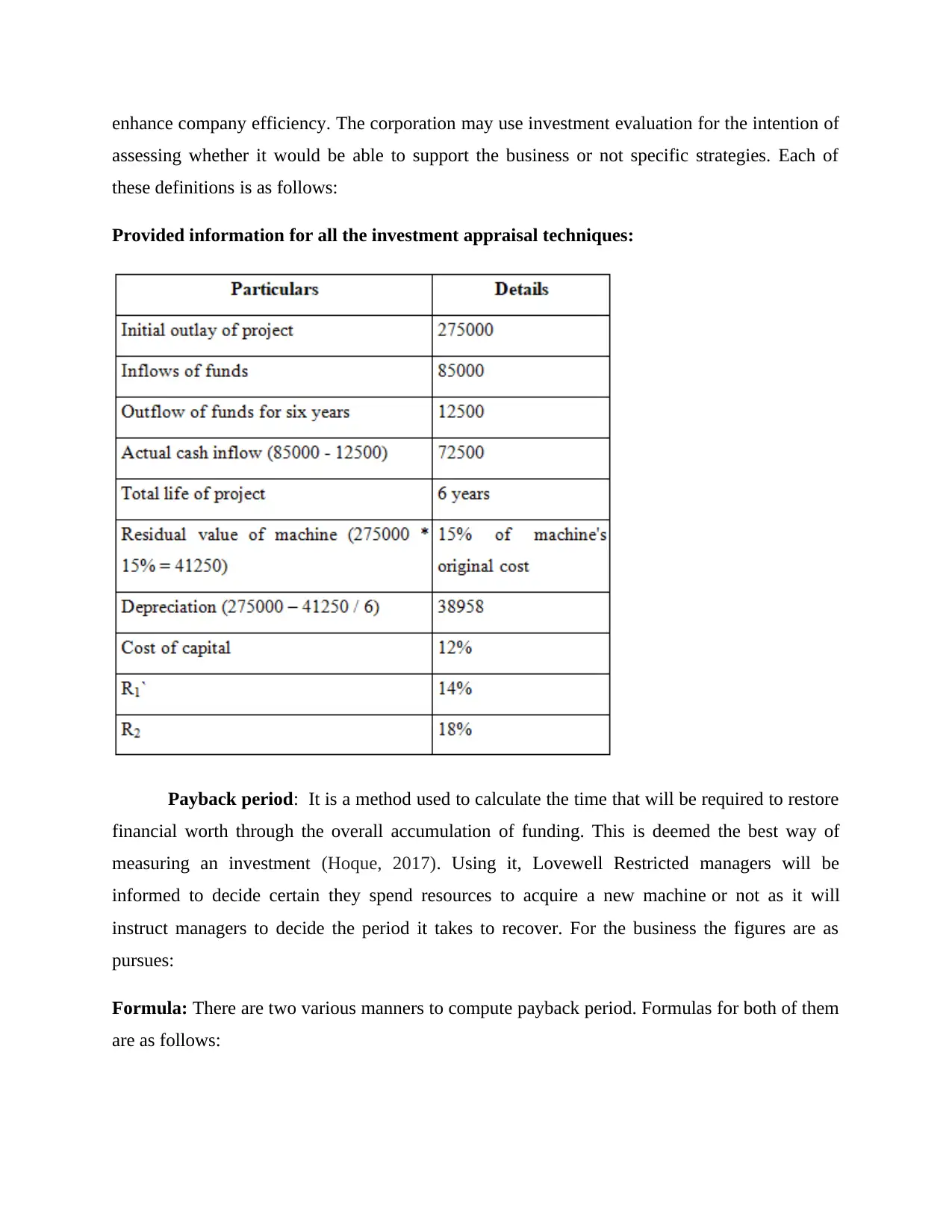
enhance company efficiency. The corporation may use investment evaluation for the intention of
assessing whether it would be able to support the business or not specific strategies. Each of
these definitions is as follows:
Provided information for all the investment appraisal techniques:
Payback period: It is a method used to calculate the time that will be required to restore
financial worth through the overall accumulation of funding. This is deemed the best way of
measuring an investment (Hoque, 2017). Using it, Lovewell Restricted managers will be
informed to decide certain they spend resources to acquire a new machine or not as it will
instruct managers to decide the period it takes to recover. For the business the figures are as
pursues:
Formula: There are two various manners to compute payback period. Formulas for both of them
are as follows:
assessing whether it would be able to support the business or not specific strategies. Each of
these definitions is as follows:
Provided information for all the investment appraisal techniques:
Payback period: It is a method used to calculate the time that will be required to restore
financial worth through the overall accumulation of funding. This is deemed the best way of
measuring an investment (Hoque, 2017). Using it, Lovewell Restricted managers will be
informed to decide certain they spend resources to acquire a new machine or not as it will
instruct managers to decide the period it takes to recover. For the business the figures are as
pursues:
Formula: There are two various manners to compute payback period. Formulas for both of them
are as follows:
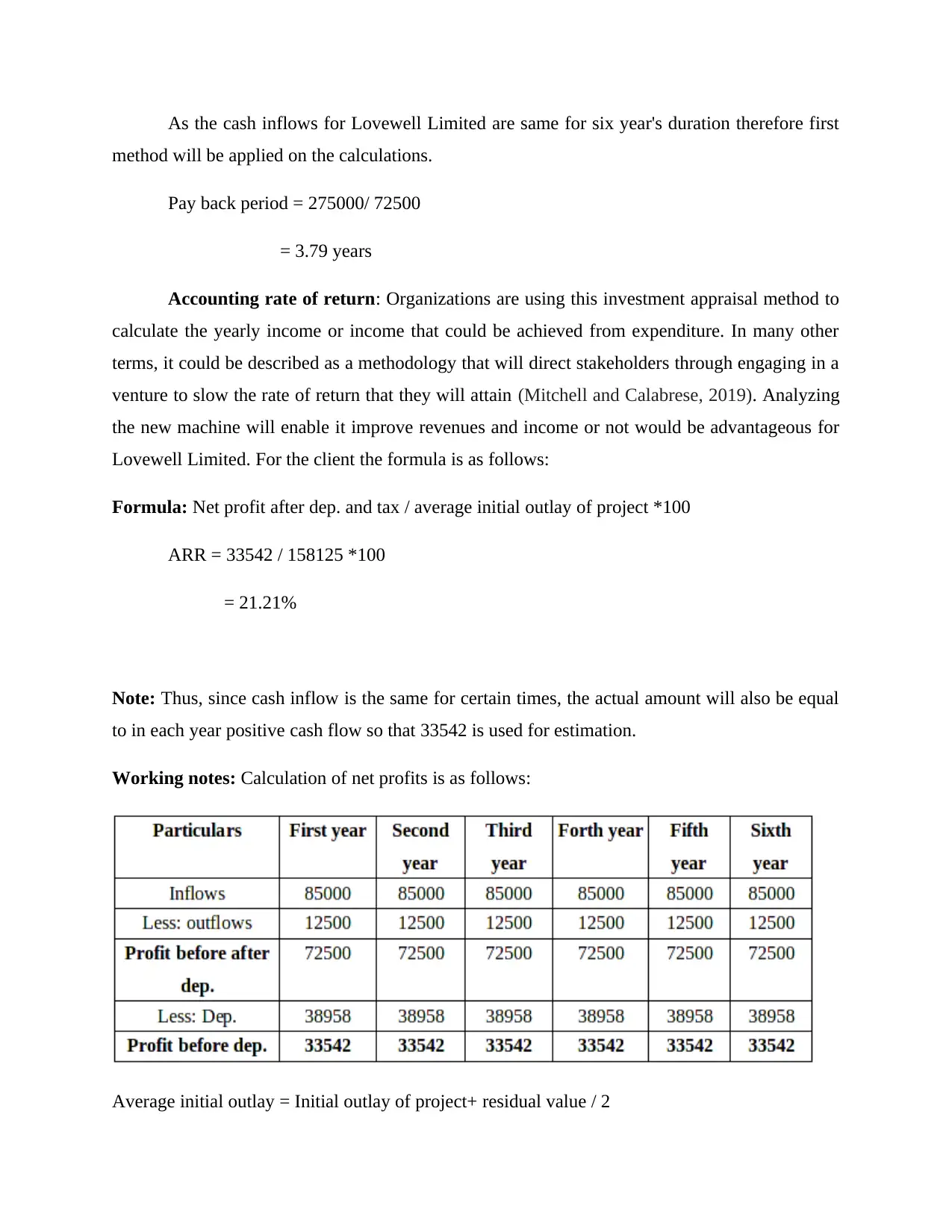
As the cash inflows for Lovewell Limited are same for six year's duration therefore first
method will be applied on the calculations.
Pay back period = 275000/ 72500
= 3.79 years
Accounting rate of return: Organizations are using this investment appraisal method to
calculate the yearly income or income that could be achieved from expenditure. In many other
terms, it could be described as a methodology that will direct stakeholders through engaging in a
venture to slow the rate of return that they will attain (Mitchell and Calabrese, 2019). Analyzing
the new machine will enable it improve revenues and income or not would be advantageous for
Lovewell Limited. For the client the formula is as follows:
Formula: Net profit after dep. and tax / average initial outlay of project *100
ARR = 33542 / 158125 *100
= 21.21%
Note: Thus, since cash inflow is the same for certain times, the actual amount will also be equal
to in each year positive cash flow so that 33542 is used for estimation.
Working notes: Calculation of net profits is as follows:
Average initial outlay = Initial outlay of project+ residual value / 2
method will be applied on the calculations.
Pay back period = 275000/ 72500
= 3.79 years
Accounting rate of return: Organizations are using this investment appraisal method to
calculate the yearly income or income that could be achieved from expenditure. In many other
terms, it could be described as a methodology that will direct stakeholders through engaging in a
venture to slow the rate of return that they will attain (Mitchell and Calabrese, 2019). Analyzing
the new machine will enable it improve revenues and income or not would be advantageous for
Lovewell Limited. For the client the formula is as follows:
Formula: Net profit after dep. and tax / average initial outlay of project *100
ARR = 33542 / 158125 *100
= 21.21%
Note: Thus, since cash inflow is the same for certain times, the actual amount will also be equal
to in each year positive cash flow so that 33542 is used for estimation.
Working notes: Calculation of net profits is as follows:
Average initial outlay = Initial outlay of project+ residual value / 2
⊘ This is a preview!⊘
Do you want full access?
Subscribe today to unlock all pages.

Trusted by 1+ million students worldwide
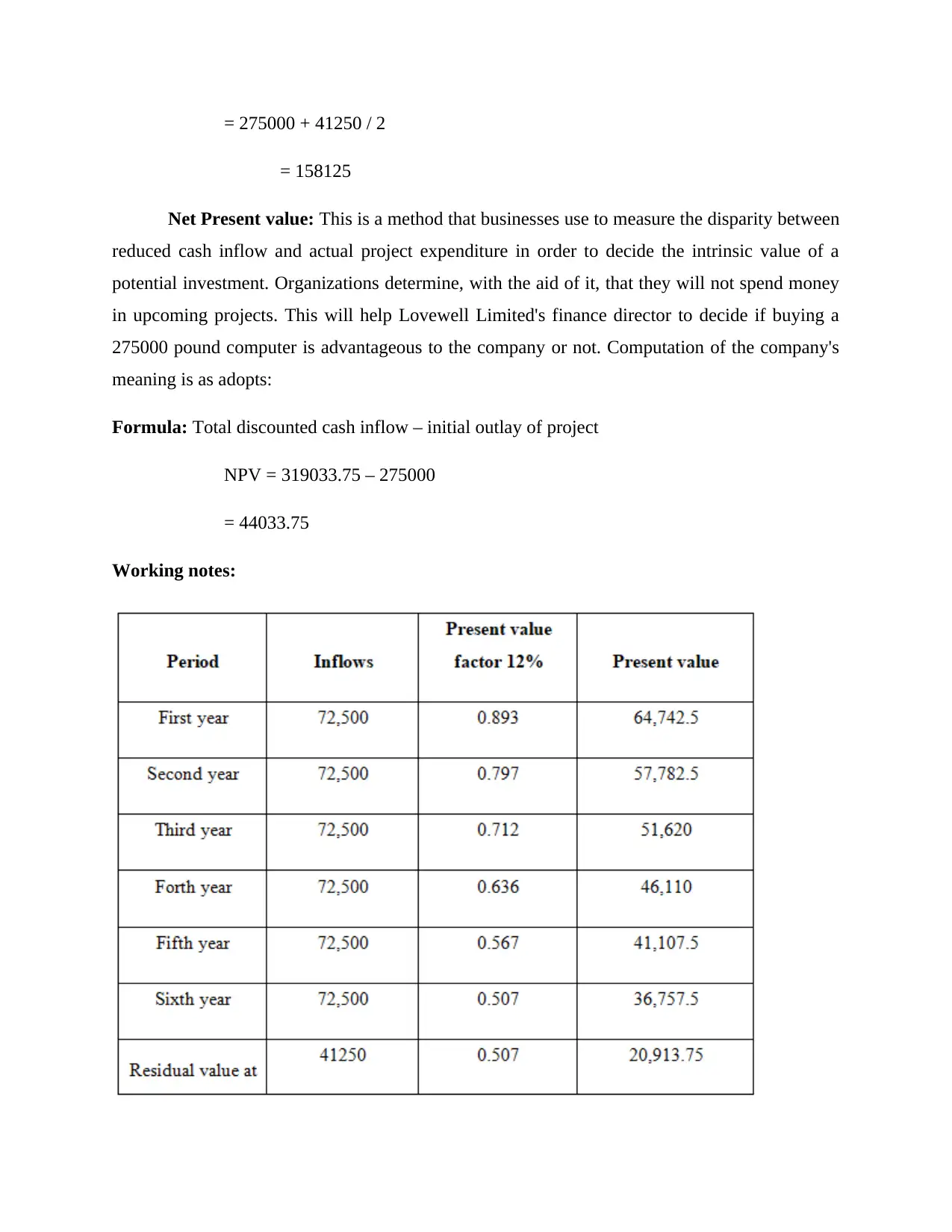
= 275000 + 41250 / 2
= 158125
Net Present value: This is a method that businesses use to measure the disparity between
reduced cash inflow and actual project expenditure in order to decide the intrinsic value of a
potential investment. Organizations determine, with the aid of it, that they will not spend money
in upcoming projects. This will help Lovewell Limited's finance director to decide if buying a
275000 pound computer is advantageous to the company or not. Computation of the company's
meaning is as adopts:
Formula: Total discounted cash inflow – initial outlay of project
NPV = 319033.75 – 275000
= 44033.75
Working notes:
= 158125
Net Present value: This is a method that businesses use to measure the disparity between
reduced cash inflow and actual project expenditure in order to decide the intrinsic value of a
potential investment. Organizations determine, with the aid of it, that they will not spend money
in upcoming projects. This will help Lovewell Limited's finance director to decide if buying a
275000 pound computer is advantageous to the company or not. Computation of the company's
meaning is as adopts:
Formula: Total discounted cash inflow – initial outlay of project
NPV = 319033.75 – 275000
= 44033.75
Working notes:
Paraphrase This Document
Need a fresh take? Get an instant paraphrase of this document with our AI Paraphraser
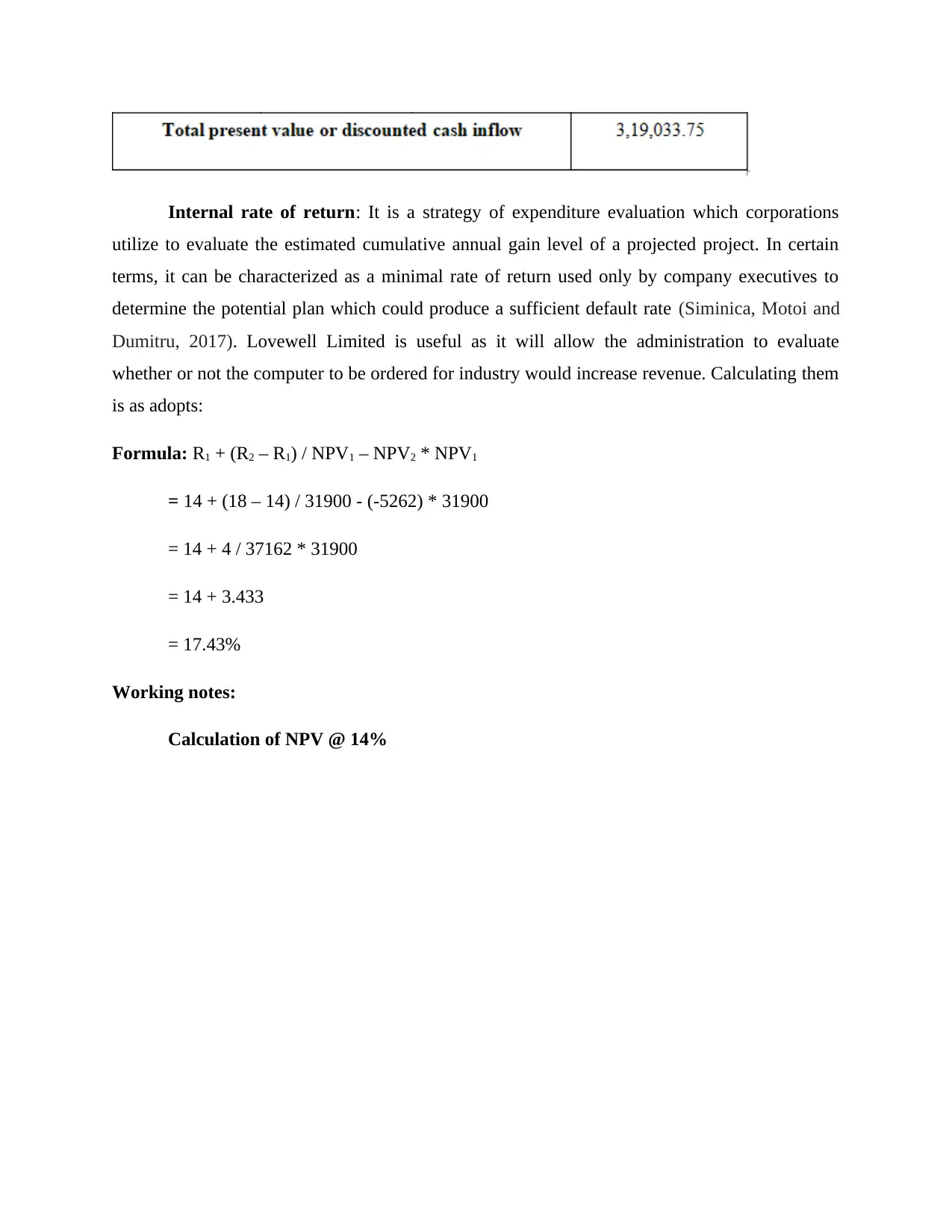
Internal rate of return: It is a strategy of expenditure evaluation which corporations
utilize to evaluate the estimated cumulative annual gain level of a projected project. In certain
terms, it can be characterized as a minimal rate of return used only by company executives to
determine the potential plan which could produce a sufficient default rate (Siminica, Motoi and
Dumitru, 2017). Lovewell Limited is useful as it will allow the administration to evaluate
whether or not the computer to be ordered for industry would increase revenue. Calculating them
is as adopts:
Formula: R1 + (R2 – R1) / NPV1 – NPV2 * NPV1
= 14 + (18 – 14) / 31900 - (-5262) * 31900
= 14 + 4 / 37162 * 31900
= 14 + 3.433
= 17.43%
Working notes:
Calculation of NPV @ 14%
utilize to evaluate the estimated cumulative annual gain level of a projected project. In certain
terms, it can be characterized as a minimal rate of return used only by company executives to
determine the potential plan which could produce a sufficient default rate (Siminica, Motoi and
Dumitru, 2017). Lovewell Limited is useful as it will allow the administration to evaluate
whether or not the computer to be ordered for industry would increase revenue. Calculating them
is as adopts:
Formula: R1 + (R2 – R1) / NPV1 – NPV2 * NPV1
= 14 + (18 – 14) / 31900 - (-5262) * 31900
= 14 + 4 / 37162 * 31900
= 14 + 3.433
= 17.43%
Working notes:
Calculation of NPV @ 14%
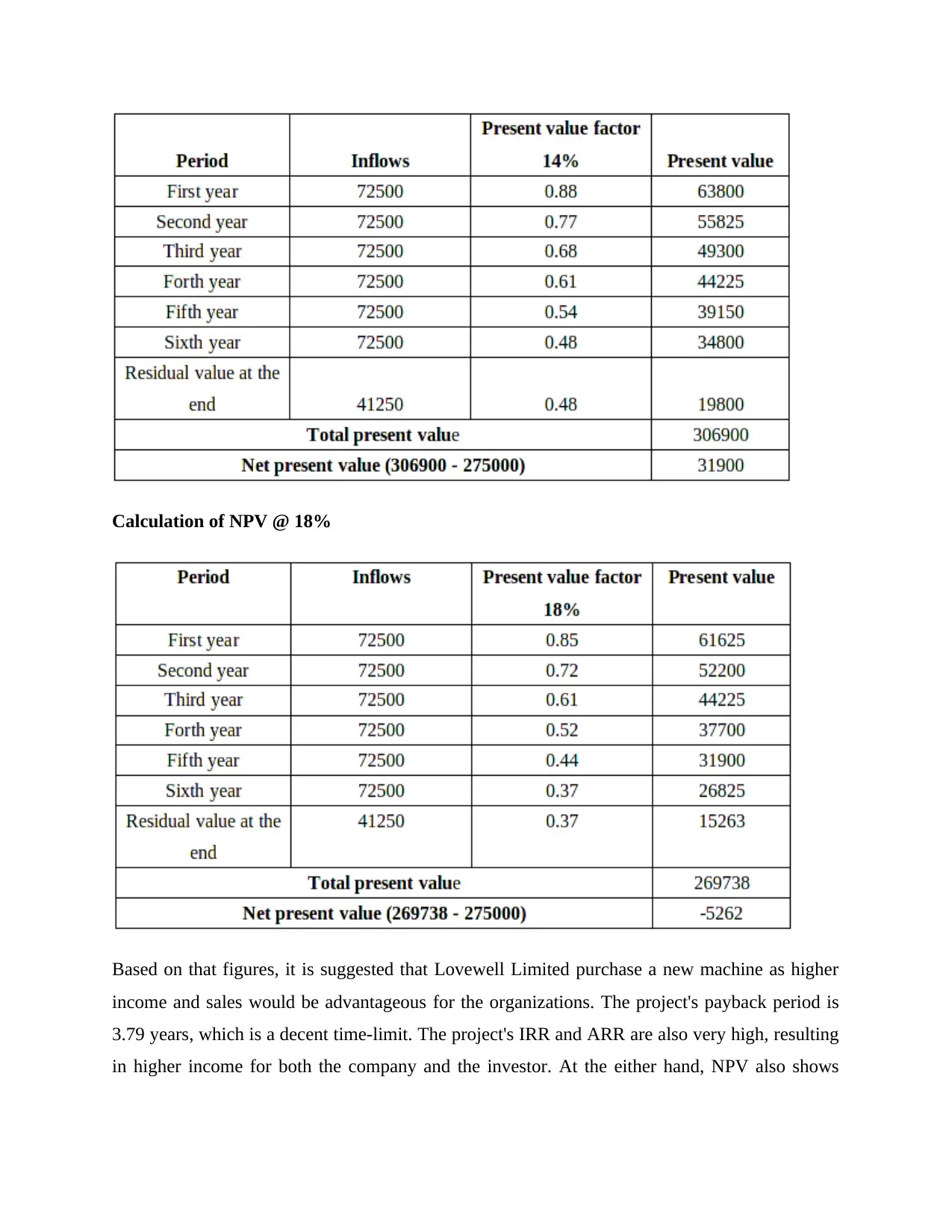
Calculation of NPV @ 18%
Based on that figures, it is suggested that Lovewell Limited purchase a new machine as higher
income and sales would be advantageous for the organizations. The project's payback period is
3.79 years, which is a decent time-limit. The project's IRR and ARR are also very high, resulting
in higher income for both the company and the investor. At the either hand, NPV also shows
Based on that figures, it is suggested that Lovewell Limited purchase a new machine as higher
income and sales would be advantageous for the organizations. The project's payback period is
3.79 years, which is a decent time-limit. The project's IRR and ARR are also very high, resulting
in higher income for both the company and the investor. At the either hand, NPV also shows
⊘ This is a preview!⊘
Do you want full access?
Subscribe today to unlock all pages.

Trusted by 1+ million students worldwide
1 out of 16
Related Documents
Your All-in-One AI-Powered Toolkit for Academic Success.
+13062052269
info@desklib.com
Available 24*7 on WhatsApp / Email
![[object Object]](/_next/static/media/star-bottom.7253800d.svg)
Unlock your academic potential
Copyright © 2020–2025 A2Z Services. All Rights Reserved. Developed and managed by ZUCOL.





